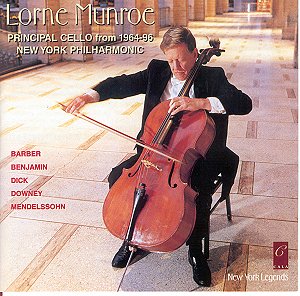I hope that this Cala disc has sold well. It deserves
to. It was issued in 1998 with eleven others, each taking as its 'axle'
the principal of one of the sections of the NYPO. The series offers
up 38 world premieres most of which are by native-born citizens of the
USA or those who made their lives there. I have not heard the other
discs in the series and I wonder how well they have done outside auditorium
sales at NYPO concerts.
Munroe has a proud, unshakable tone, noble and bold,
recessed and sensitive when called for.
I heard this disc just after hearing Raya Garbousova's
pioneering recording of the Barber. Garbousova takes 16.58 against
Munroe's 18.55 and I must say that the Barber emerges in a much more
sympathetic and emotive light in Munroe's more expansive conception.
The work dates from the 1930s at the end of the composer's student period.
It deserves to breathe a more romantic oxygen than Garbousova permits
it. Munroe has the measure of the work.
The Dick work is sensitive, rounded and tonal and not
at all unapproachable. He was principal viola of the Vienna Symphony
(1924-7) and the Cleveland (1943-9). He was principal of the music theory
department at Cleveland Institute of Music (1948;-73). His Symphony
was premiered in 1950. Munroe premiered the present work.
The Benjamin (one of my avocations) swings easily along
with a Gallic nonchalance and a touching innocence: listen to the Minuet
(track 10) at 0.48 onwards. Munroe's recording is well worth having
for its sentimental fancies and because it documents the dedicatee's
hand on the tiller. Nothing jazzy here; nor for that matter anything
of Jamaica; the Rumba is contemporaneous with the Sonatina. The Sonatina
was written for Munroe in 1937 when the cellist was only thirteen. Composer
and cellist toured Europe during the late 1930s.
John Downey is the only living composer represented.
A pupil of Vittorio Rieti and Rudolph Ganz he studied also with Nadia
Boulanger just after the Second World War. His teachers during his seven
Parisian years were Honegger, Milhaud and Messiaen. There is an orchestral
anthology of Downey works on CALA CACD1003. The Lydian Suite was
written for Downey's daughter, Lida. It is in five movements with the
longest, surprisingly enough, being the central presto. The composer
assures us that the work incorporates modal inflections around the name
'Lida'. The outer Largamente and Allegro speak with unforced
eloquence and quickly gain the new listener's sympathy in a way that
the inner trio do not.
In this collection the Mendelssohn, which is the single
largest work, seems ill at ease. It is played fluently enough though
does not register remarkably. Stylistically it grates in this company
or it seems to be going through the motions. Played alone and distinct
from its companions it is pleasingly done with the laurels going to
the harp-like decoration of the Allegretto scherzando. As a work
it lacks the ebullient lissom spontaneity of the Octet.
My first impressions before hearing the disc was that
I was to be treated to a mixed bag of classical (Mendelssohn), Late
Romantic (Barber) and forbidding 'Modern'. In fact the Dick and Downey
are not at all hard-going. The Dick is worth hearing and I expect you
will want to hear more by him. The Downey may need some persistence
though the outer movements are a cinch for anyone.
The thorough notes, which dwell a mite too much on
musical technicality, are by the admirable Ates Orga.
Munroe is an eloquent player who reminded me of the
young Yo Yo Ma in the Finzi Cello Concerto (a long deleted Lyrita LP)
before stardom dawned. I would love to hear Munroe in the Finzi, the
Kodaly (both the accompanied and the unaccompanied), the Bax Rhapsody
and the John Foulds Cello Sonata. Any one or more of these works would
have been preferable to the Mendelssohn.
Will I ever get the opportunity to hear Munroe in other
repertoire. I hope so. It would be good to hear him in the Brahms Double
Concerto or the Elgar.
Mature and flowing playing distinguish this disc which
is at its best in the Barber, Benjamin and Dick works. The NYPO were
fortunate indeed during Mr Munroe's tenure.
Rob Barnett
The New York Legends series on CALA
Joseph Alessi (trombone) CACD0508
Jeanne Baxstresser (flute) CACD0512
Glenn Dicterow (violin) CACD0514
Stanley Drucker (clarinet) CACD0509
Judith LeClair (bassoon) CACD0515
Eugene Levinson (double bass) CACD0507
Lorne Munroe (cello) CACD0517
Philip Myers (horn) CACD0513
Cynthia Phelps (viola) CACD0510
Joseph Robinson (oboe) CACD0518
Philip Smith (trumpet) CACD0516
Thomas Stacy (cor anglais) CACD0511


